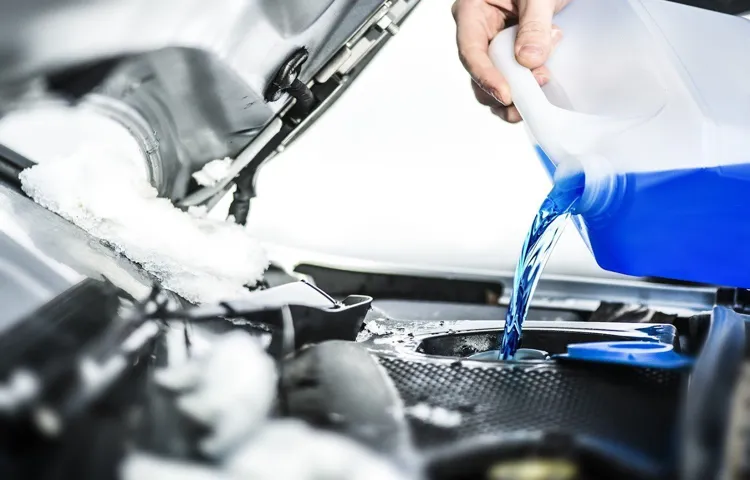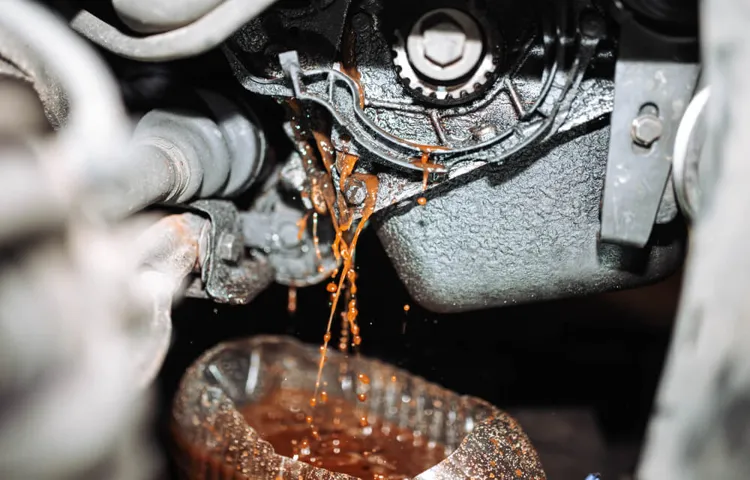Looking for a way to dispose of your old coolant but don’t know where to start? As a car owner, it is easy to overlook the importance of proper disposal of old coolant. However, it’s essential to dispose of it in an environmentally friendly manner. Old coolant contains harmful chemicals and heavy metals that can be harmful to the environment if not disposed of properly.
It can be tempting to pour it down the drain or into the trash, but this creates an environmental hazard. So, what should you do with it? In this blog, we will discuss the proper disposal of old coolant, including why it’s important and the various methods you can use. Let’s get started!
Table of Contents
Introduction
If you have old coolant in your garage or shed, it’s important to dispose of it properly. Pouring it down the drain or into the ground can harm the environment and potentially contaminate our water supply. So, where can you dispose of old coolant? First, check with your local recycling center or hazardous waste facility to see if they accept coolant.
Many places have specific guidelines on how to properly dispose of these types of materials, so it’s important to follow their instructions. If there are no facilities nearby that accept coolant, check with local automotive shops or service stations. They may have a system in place for recycling coolant, or be able to direct you to a safe and responsible disposal location.
Remember, proper disposal of coolant protects our environment and our health.
Explaining the importance of proper disposal and its impact on the environment
Proper Disposal Proper disposal is a crucial aspect of waste management. It involves getting rid of waste in a manner that does not harm the environment, by ensuring that it is collected, transported, and disposed of in a safe and sustainable manner. Proper disposal reduces the amount of waste that ends up in landfills or dumped in the natural environment, thus reducing the harm caused by pollution.
The impact of improper disposal ranges from aesthetic to environmental and even health issues. For instance, waste that is thrown in open areas such as streets, rivers, or oceans can lead to blocked drainage systems that may cause flooding, which in turn can contaminate water sources and increase the incidence of waterborne diseases. Additionally, improper disposal of otherwise harmless, everyday household items such as batteries, light bulbs, or electronics can release hazardous chemicals into the environment, which can cause soil and water pollution, harm biodiversity, and even have long-term health effects on humans and wildlife.
In conclusion, proper disposal of waste is essential in ensuring a clean and healthy environment for all living things.

Safety Precautions
As a responsible car owner, disposing of old coolant properly is crucial for the safety of both the environment and humans. Coolant can contain hazardous materials like ethylene glycol, which can be harmful if ingested by animals or humans. So, where should you dispose of old coolant? The best option is to take it to a local recycling center.
Most recycling centers have specific areas for hazardous waste like old coolant, where it can be safely handled and processed. In addition, some automotive service centers and dealerships may also offer coolant recycling services. Never pour old coolant down the drain or onto the ground, as it can contaminate the soil and groundwater.
Taking the extra step to properly dispose of old coolant helps protect the environment and ensures the safety of those around you.
Listing the steps to safely handle old coolant for disposal
When it comes to safely handling old coolant for disposal, there are a few important safety precautions that you should keep in mind. First and foremost, it is important to wear protective clothing such as gloves and goggles to avoid any potential splashes or exposure to the fluid. Additionally, make sure to store the coolant in a secure container that is properly labeled to avoid any accidents or confusion.
Before disposing of the coolant, be sure to carefully pour it into an appropriate disposal container that meets the requirements of your local waste management program. Remember, coolant can be dangerous if not handled properly, so it is important to take all necessary safety precautions to avoid any potential risks or hazards. By following these simple steps, you can safely and responsibly dispose of old coolant while doing your part to protect the environment.
Highlighting potential hazards and necessary safety measures to prevent accidents
When it comes to ensuring safety in any workplace, taking precautions is always better than dealing with an accident. Workers should know the potential hazards they might face while on the job, and what measures they can take to prevent accidents. For instance, using protective equipment like gloves, helmets, and glasses can protect workers from injuries.
Employers should regularly inspect the workplace to identify potential hazards and take appropriate actions to eliminate or mitigate them. Routine safety training can also create awareness and help workers adhere to safety regulations. It’s important to note that safety is not just the employer’s responsibility; every worker should be responsible for their own safety as well as their colleagues.
By following the necessary protocols and being vigilant, accidents can be prevented, and everyone can go home safely at the end of the day. Overall, safety precautions should be a top priority for every workplace, whether it’s a busy construction site or an office setting.
Where to Dispose of Old Coolant
When it comes to getting rid of old coolant, it’s important to do so properly in order to protect the environment and prevent any potential hazards. Many auto parts stores and service centers will accept used coolant for disposal, sometimes even for free. Additionally, some municipalities offer hazardous waste collection programs where you can drop off old coolant and other hazardous materials.
It is important to never pour coolant down a drain or into the ground, as it can contaminate water sources and harm wildlife. So if you’re unsure of where to dispose of old coolant, be sure to check with your local auto parts store or municipality to find a safe and responsible solution.
If you need to dispose of old coolant, it’s important to do so through authorized disposal sites and recycling centers. Improper disposal of coolant can be harmful to the environment and potentially hazardous to human health. One option for disposal is to bring the coolant to an auto repair shop that offers coolant recycling services.
These shops can safely and responsibly dispose of the old coolant. Another option is to look for a household hazardous waste disposal facility in your area. These facilities are designed for the proper disposal of a variety of hazardous materials, including coolant.
Many facilities offer drop-off hours for residents, making it easy to dispose of old coolant in a safe and environmentally friendly way. Remember, it is important to never pour coolant down the drain or into the ground, and to always wear proper protective gear when handling hazardous materials. Keyword: authorized disposal sites
Listing regulations and laws to be aware of before disposing of coolant
When it comes to disposing of old coolant, it’s important to be aware of the regulations and laws in your area. Improper disposal of coolant can cause harm to the environment and even lead to fines or legal consequences. In order to properly dispose of old coolant, it’s important to find a licensed waste disposal facility that adheres to the regulations set by your local or state government.
Some areas may also have specific requirements for the containers used to transport the coolant. It’s always better to err on the side of caution and seek out professional disposal options rather than risking any negative outcomes. By taking the time to research and comply with local regulations, you can safely dispose of your old coolant while also doing your part to protect the environment.
Alternative Disposal Methods
If you are wondering where to dispose of old coolant, you have a few options. One option is to take it to a recycling facility that accepts hazardous waste. They will often have special procedures in place to dispose of it safely.
You can also contact your local landfill or waste management facility to ask if they have a program for recycling coolant. Some auto parts stores may also accept old coolant for recycling. It is important to properly dispose of coolant because it contains ethylene glycol, which is toxic to humans and animals.
Dumping it down the drain or on the ground can contaminate the environment and harm wildlife. So, be sure to do your part and dispose of old coolant responsibly.
Discussing eco-friendly and safe disposal options for old coolant
When it comes to disposing of old coolant, it’s important to do so in an eco-friendly and safe manner. One alternative method is to recycle the coolant. This involves collecting the used coolant and sending it to a recycling facility where it can be cleaned, filtered, and tested to ensure it meets the manufacturer’s specifications.
Another option is to use a coolant recovery system, which captures and reclaims the coolant from the machine for reuse. If recycling or recovery isn’t possible, then disposing of the coolant at a hazardous waste facility is necessary. It’s crucial to check with your local waste management authorities to ensure that the coolant is disposed of correctly.
Remember, coolant can contain harmful chemicals that can harm the environment and its inhabitants, so proper disposal is crucial. By opting for an eco-friendly and safe disposal option, you’re doing your part to protect the planet.
Explaining how to properly recycle and dispose of old coolant by yourself
Recycling old coolant can be a tricky task, but it’s important to dispose of it properly to ensure the safety of both humans and the environment. While the most common method of disposing of old coolant is to take it to a recycling center, there are alternative methods you can use if the center isn’t available or doesn’t accept the type of coolant you have. For example, you can use a vacuum pump to remove the old coolant from your vehicle’s cooling system and store it in a clean and sealed container.
Then, you can transport the container to a disposal site that accepts hazardous materials. Another option is to mix the old coolant with an absorbent material, such as sawdust or kitty litter, to solidify it before disposing of it in the trash. However, it’s important to note that this method should be a last resort, as mixing coolant with certain materials can produce toxic fumes.
By following these alternative disposal methods, you can ensure that your old coolant is properly recycled or disposed of, without harming yourself or the environment in the process.
Conclusion
In the end, dumping old coolant down the drain is not only harmful to the environment, it’s also bad for your plumbing. Instead, take it to a professional facility or contact your local waste management department for proper disposal. Your car and Mother Nature will thank you for being a responsible coolant dumper!”
Recap of the importance of proper disposal and the consequences of improper disposal
Alternative Disposal Methods Proper disposal of waste is important for the environment, public health, and safety. When waste is not disposed of properly, it can pollute the air and water, harm wildlife, and even cause serious illness or death. Improper disposal can also result in legal consequences and fines.
In order to address this issue, alternative disposal methods have been developed to provide environmentally-friendly alternatives to traditional landfill disposal. For instance, waste-to-energy (WTE) facilities offer a way to generate electricity from waste by incinerating it and capturing the heat produced. Another alternative method is composting, which is a natural process that breaks down organic waste into nutrient-rich soil that can be used for gardening.
These alternative disposal methods not only reduce the amount of waste sent to landfills but also provide renewable energy sources and contribute to a healthier environment. By using these eco-friendly methods for waste disposal, we can help protect the planet for future generations to come.
FAQs
What should I do with old coolant?
Old coolant should never be disposed of by pouring it down the drain or onto the ground. It should be taken to a recycling center or hazardous waste collection facility.
Can I mix old and new coolant?
It is not recommended to mix old and new coolant as it can lead to inconsistent performance and potential damage to the engine. It is best to completely flush the old coolant before adding new coolant.
How do I know when it’s time to change my coolant?
It’s recommended to change coolant every 2 to 5 years, depending on the manufacturer’s recommendations. A coolant test kit can also be used to determine if the coolant needs to be changed.
Is it safe to dispose of coolant in the trash?
No, coolant should never be disposed of in the trash. It should be taken to a recycling center or hazardous waste collection facility.
Can I reuse old coolant?
Reusing old coolant is not recommended as it can contain contaminants and contaminants that can cause engine damage. It’s best to properly dispose of old coolant and use fresh coolant.
What is the proper way to dispose of coolant?
The proper way to dispose of coolant is to take it to a recycling center or hazardous waste collection facility. These facilities can properly dispose of the coolant and recycle the materials.
What should I do if I accidentally spill coolant?
If coolant is spilled, it should be immediately cleaned up using absorbent materials such as kitty litter or paper towels. The contaminated materials should be disposed of properly at a recycling center or hazardous waste collection facility.



